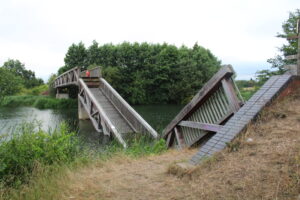Multiple timber footbridge failures – due to concept, material specification/selection, manufacture, transport, construction, inspection and maintenance. These are common and systemic issues that result in a reduction in the design life expectancy and a loss of value for money. Who will be held accountable?
Below is a listing of links to facilitate your access to the increasing number of pages recording evidence on multiple timber footbridge failures. Most of the links below lead to further information on this site and highlight common (actually systemic) failures.

Timber footbridges over the Jubilee River include Berry Hill, Ashford Lane, The Myrke and Black Potts. There are more. Temple footbridge over the River Thames has been closed for two years and has the similar issues.
The Question still to be answered is – who is going to pay to replace these sub-standard footbridges? Undoubtedly, we the taxpayers will ultimately pay – but through which Authority and who will be held accountable?
Temple footbridge – River Thames Closure Notice
Black Potts footbridge – a 45 second YouTube video
Ashford Lane footbridge replacement
The causes of multiple timber footbridge failure
Black Potts footbridge – timber decay images
Black Potts footbridge problem on RBWM Meeting Agenda
Black Potts footbridge should be closed
Temple footbridge still closed after two years
Ashford Lane footbridge inspection reports
AI answer on the design life of timber footbridges
BBC News – Ashford Lane footbridge collapse
Ashford Lane footbridge – Bucks CC issues safety warning
Berry Hill Footbridge inspection letter from BCC dated 3-7-2024
Temple Footbridge closed (May 2023) until further notice (maybe £8m to replace)
Berry Hill footbridge – partially repaired but still rotting (£0.5m spent to date)
Ashford Lane Footbridge (Dorney) collapsed into Jubilee River (June 2025) (say £2m to replace)
Ashford Lane footbridge 74 page inspection report dated June 2024
Ashford Lane Footbridge 90 page report by Atkins (prior to the collapse)
Myrke footbridge (Eton to Slough) – still standing – but allow £2m to replace
The structural health of timber bridges
Temple footbridge closure – EA briefing – May 2023


Ewan – I am appalled on two counts, 1. The standard of construction, namely a , the vertical king post appears to have a wedge driven down into the main beam, indicating that the hole to receive it was too loose, the result is that the wedge pressure has over time split the main beam. The adjacent angled beam has been pinned possibly for the same reason , this appears to be a bodge at some time . The main beam ends are rotten and do not show any attempt to preserve the wood by maintenance or proper inspection, just left to rot. 2. Splits and gaps in the main beams have reduced the capacity loadings to such an extent that capacity is almost non-existent it would appear that the curved geometry construction principle of the bridge checked by the brick end piers is retaining it in place, as the main beams ends are rotten the retention will be lost and the whole thing collapse. As the flat bridge lacking geometry already has.
Q 1. have the EA ever denoted a design time life span for their bridges when they handed them to the local authorities.
Q 2. When the bridges were handed over was there a conditional clause for inspections and maintenance.
Q 3. Was a maintenance schedule from the EA ever included within the terms and conditions of the handovers.
Thank you for the additional info.
Ian.